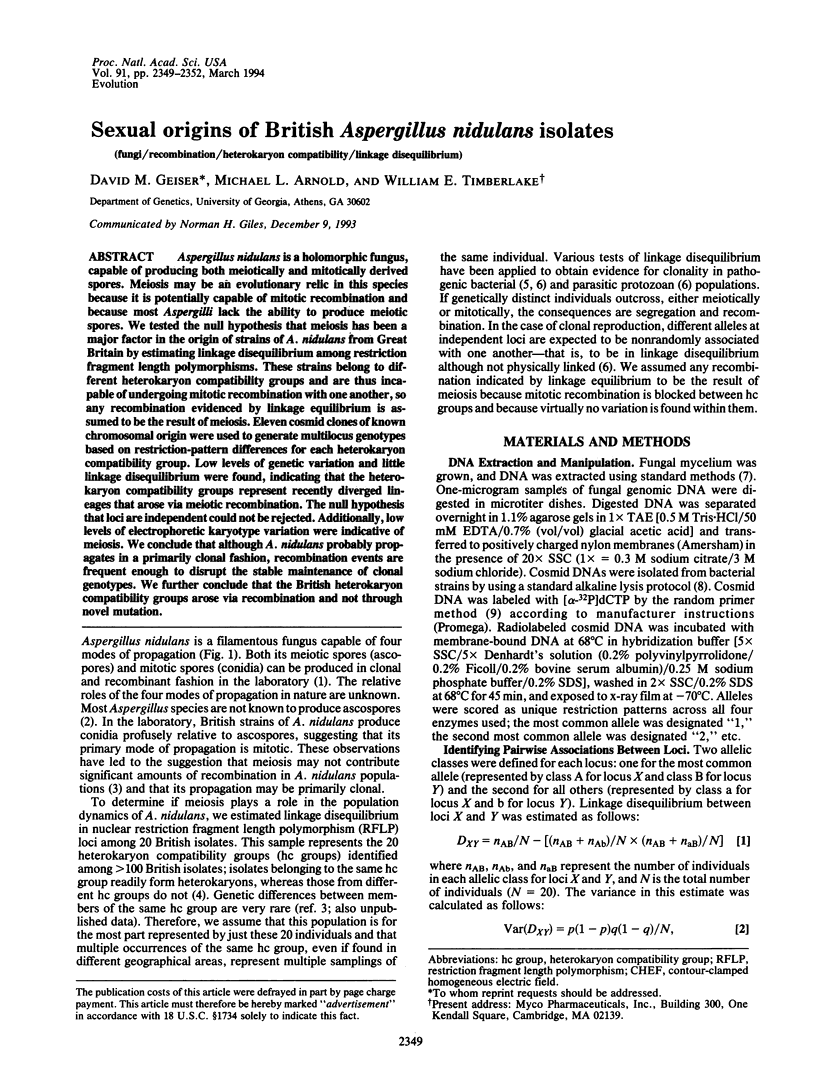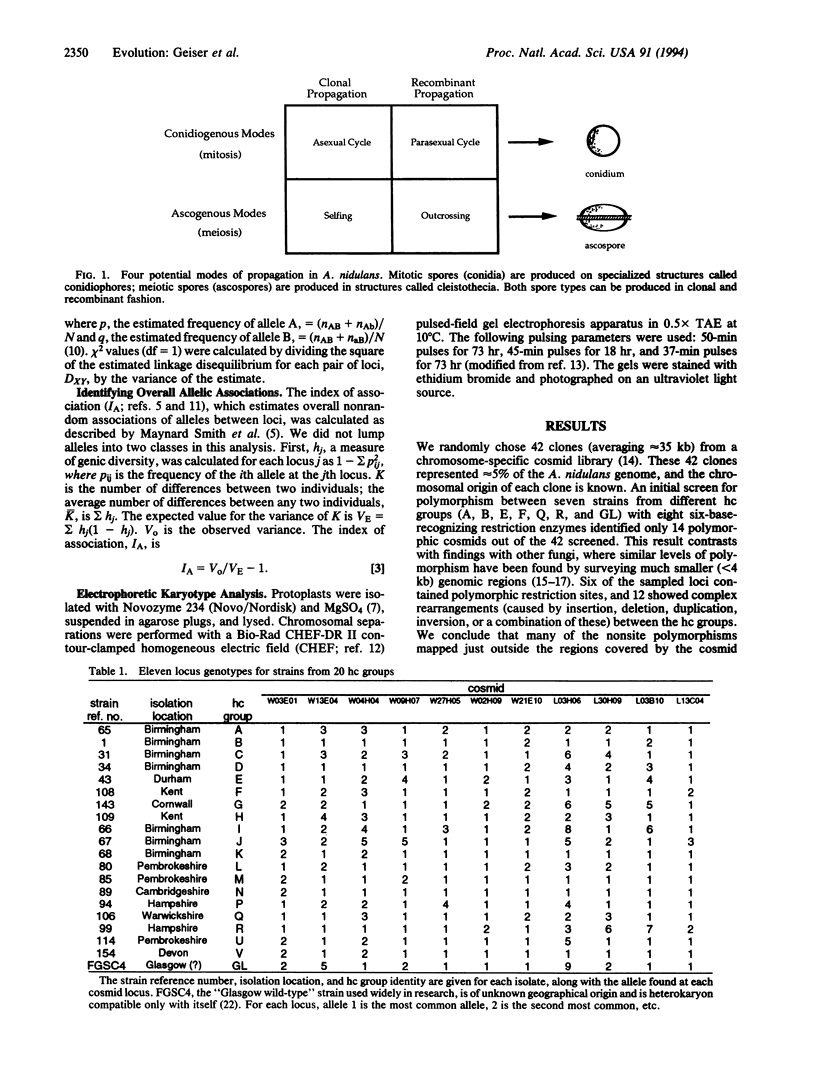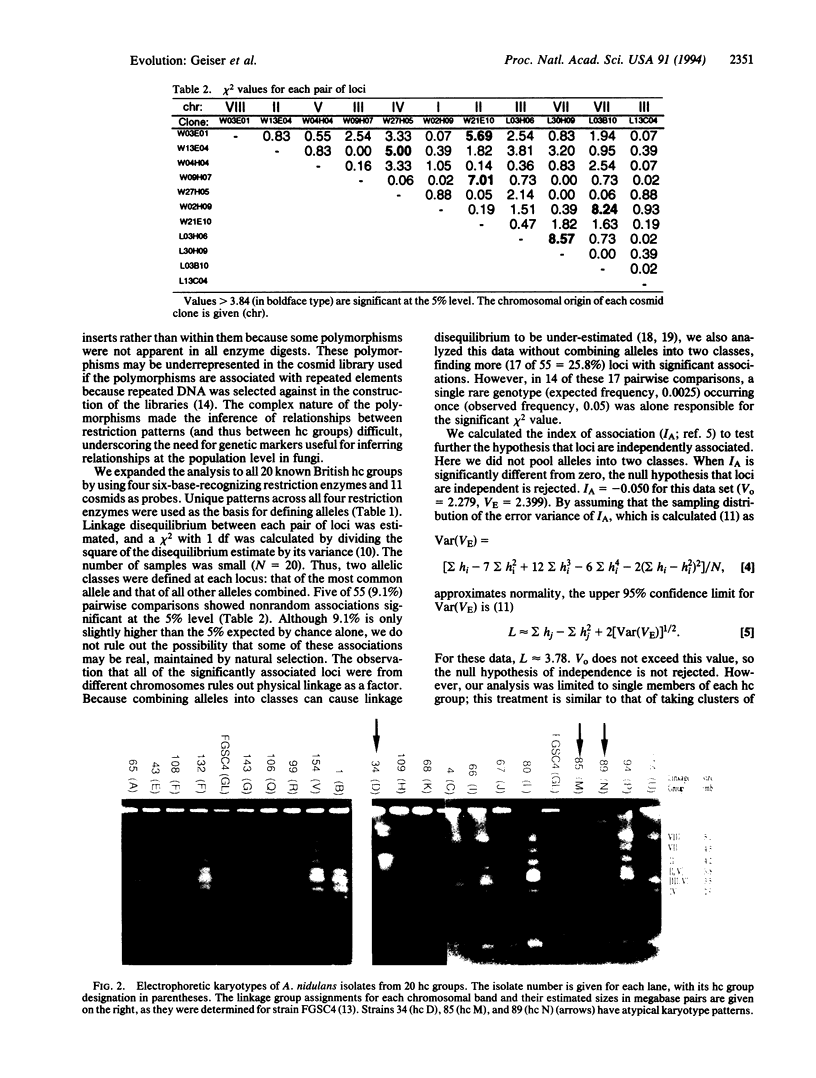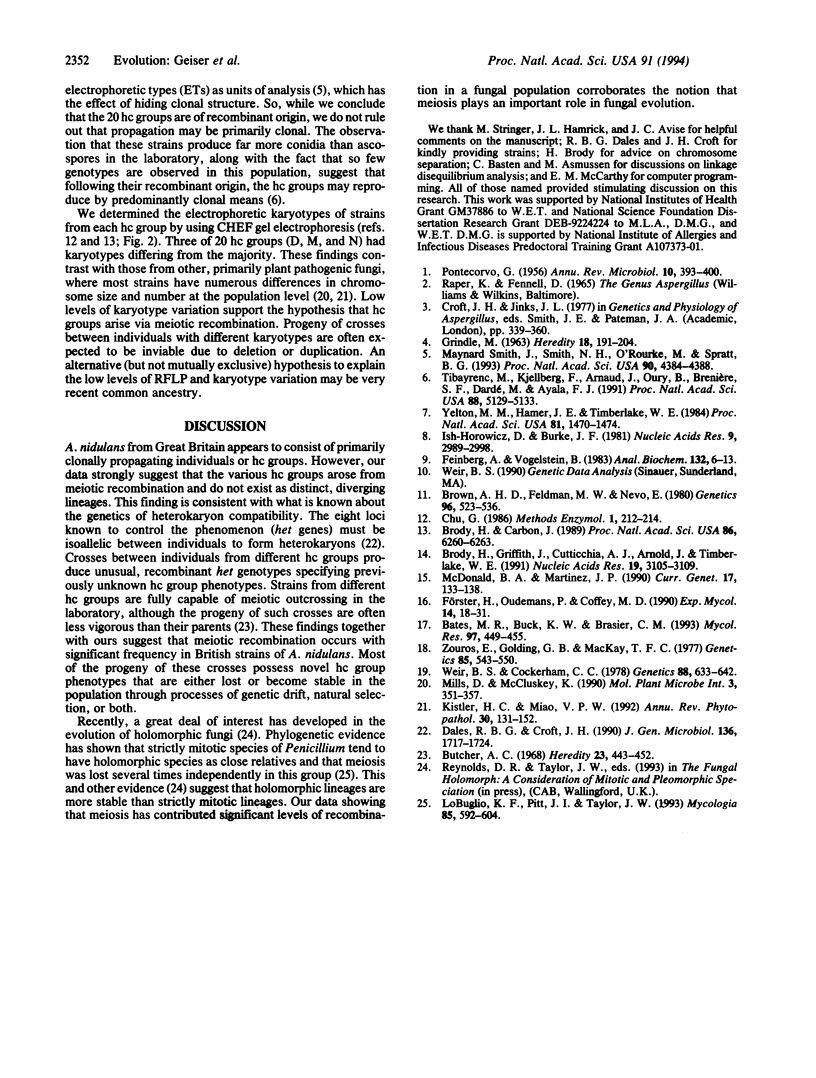Abstract
Aspergillus nidulans is a holomorphic fungus, capable of producing both meiotically and mitotically derived spores. Meiosis may be an evolutionary relic in this species because it is potentially capable of mitotic recombination and because most Aspergilli lack the ability to produce meiotic spores. We tested the null hypothesis that meiosis has been a major factor in the origin of strains of A. nidulans from Great Britain by estimating linkage disequilibrium among restriction fragment length polymorphisms. These strains belong to different heterokaryon compatibility groups and are thus incapable of undergoing mitotic recombination with one another, so any recombination evidenced by linkage equilibrium is assumed to be the result of meiosis. Eleven cosmid clones of known chromosomal origin were used to generate multilocus genotypes based on restriction-pattern differences for each heterokaryon compatibility group. Low levels of genetic variation and little linkage disequilibrium were found, indicating that the heterokaryon compatibility groups represent recently diverged lineages that arose via meiotic recombination. The null hypothesis that loci are independent could not be rejected. Additionally, low levels of electrophoretic karyotype variation were indicative of meiosis. We conclude that although A. nidulans probably propagates in a primarily clonal fashion, recombination events are frequent enough to disrupt the stable maintenance of clonal genotypes. We further conclude that the British heterokaryon compatibility groups arose via recombination and not through novel mutation.
Full text
PDF



Images in this article
Selected References
These references are in PubMed. This may not be the complete list of references from this article.
- Brody H., Carbon J. Electrophoretic karyotype of Aspergillus nidulans. Proc Natl Acad Sci U S A. 1989 Aug;86(16):6260–6263. doi: 10.1073/pnas.86.16.6260. [DOI] [PMC free article] [PubMed] [Google Scholar]
- Brody H., Griffith J., Cuticchia A. J., Arnold J., Timberlake W. E. Chromosome-specific recombinant DNA libraries from the fungus Aspergillus nidulans. Nucleic Acids Res. 1991 Jun 11;19(11):3105–3109. doi: 10.1093/nar/19.11.3105. [DOI] [PMC free article] [PubMed] [Google Scholar]
- Brown A. H., Feldman M. W., Nevo E. Multilocus Structure of Natural Populations of HORDEUM SPONTANEUM. Genetics. 1980 Oct;96(2):523–536. doi: 10.1093/genetics/96.2.523. [DOI] [PMC free article] [PubMed] [Google Scholar]
- Butcher A. C. The relationship between sexual outcrossing and heterokaryon incompatibility in Aspergillus nidulans. Heredity (Edinb) 1968 Aug;23(3):443–452. doi: 10.1038/hdy.1968.55. [DOI] [PubMed] [Google Scholar]
- Dales R. B., Croft J. H. Investigation of the het genes that control heterokaryon incompatibility between members of heterokaryon-compatibility (h-c) groups A and G1 of Aspergillus nidulans. J Gen Microbiol. 1990 Sep;136(9):1717–1724. doi: 10.1099/00221287-136-9-1717. [DOI] [PubMed] [Google Scholar]
- Feinberg A. P., Vogelstein B. A technique for radiolabeling DNA restriction endonuclease fragments to high specific activity. Anal Biochem. 1983 Jul 1;132(1):6–13. doi: 10.1016/0003-2697(83)90418-9. [DOI] [PubMed] [Google Scholar]
- GRINDLE M. Heterokaryon compatibility of unrelated strains in the Aspergillus nidulans group. Heredity (Edinb) 1963 May;18:191–204. doi: 10.1038/hdy.1963.21. [DOI] [PubMed] [Google Scholar]
- Ish-Horowicz D., Burke J. F. Rapid and efficient cosmid cloning. Nucleic Acids Res. 1981 Jul 10;9(13):2989–2998. doi: 10.1093/nar/9.13.2989. [DOI] [PMC free article] [PubMed] [Google Scholar]
- PONTECORVO G. The parasexual cycle in fungi. Annu Rev Microbiol. 1956;10:393–400. doi: 10.1146/annurev.mi.10.100156.002141. [DOI] [PubMed] [Google Scholar]
- Smith J. M., Smith N. H., O'Rourke M., Spratt B. G. How clonal are bacteria? Proc Natl Acad Sci U S A. 1993 May 15;90(10):4384–4388. doi: 10.1073/pnas.90.10.4384. [DOI] [PMC free article] [PubMed] [Google Scholar]
- Tibayrenc M., Kjellberg F., Arnaud J., Oury B., Brenière S. F., Dardé M. L., Ayala F. J. Are eukaryotic microorganisms clonal or sexual? A population genetics vantage. Proc Natl Acad Sci U S A. 1991 Jun 15;88(12):5129–5133. doi: 10.1073/pnas.88.12.5129. [DOI] [PMC free article] [PubMed] [Google Scholar]
- Weir B. S., Cockerham C. C. Testing Hypotheses about Linkage Disequilibrium with Multiple Alleles. Genetics. 1978 Mar;88(3):633–642. doi: 10.1093/genetics/88.3.633. [DOI] [PMC free article] [PubMed] [Google Scholar]
- Yelton M. M., Hamer J. E., Timberlake W. E. Transformation of Aspergillus nidulans by using a trpC plasmid. Proc Natl Acad Sci U S A. 1984 Mar;81(5):1470–1474. doi: 10.1073/pnas.81.5.1470. [DOI] [PMC free article] [PubMed] [Google Scholar]
- Zouros E., Golding G. B., MacKay T. F. The effect of combining alleles into electrophoretic classes on detecting linkage disequilibrium. Genetics. 1977 Mar;85(3):543–550. doi: 10.1093/genetics/85.3.543. [DOI] [PMC free article] [PubMed] [Google Scholar]



